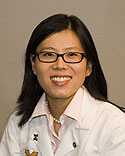Mechanisms of leukocyte recruitment to the lung during idiopathic pneumonia syndrome following allogeneic bone marrow transplantation.

Project Goal
My research focus has been in the study of graft versus host disease. While in the lab with Dr. Ken Cooke as my mentor, my initial project examined the role of leukocyte migration in a murine model of allogeneic bone marrow transplantation (BMT). I specifically worked on a chemokine receptor known as CCR1 and evaluated its effect in the development of systemic and target organ GVHD.
Results
In this project, we used a well-established murine BMT model and demonstrated that the expression of CCR1 on donor cells significantly contributed to the development of acute GVHD. We found that the expression of CCR1 on donor T cells was dominant and modulated T cell alloreactivity both in vitro and in vivo through a mechanism that was dependent on receptor-ligand interactions with CCL5/RANTES (regulated on activation, normal T expressed and secreted). These findings were subsequently published in Blood: Choi et al. “CCR1/CCL5 (RANTES) receptor-ligand interactions modulate allogeneic T cell responses and graft versus host disease following stem cell transplantation.” Blood (2007) 110(9):3447-3455.
Impact
Allogeneic BMT is an important therapeutic option for a variety of pediatric cancers as well as non-malignant disorders. However, acute GVHD is the most frequent and serious complication following allogeneic BMT and continues to limit the broader application of this therapy. And so, a better understanding of the mechanisms responsible for these graft versus host reactions may ultimately allow for directed therapies that promote GVL while reducing GVHD. Our findings contribute to this end.
Next Steps
I remain committed in translational research where my focus is in developing GVHD prevention and treatment strategies. My long-term career goal is to become an independent clinical / translational investigator in the field of bone marrow transplantation, with particular expertise in the treatment and management of acute GVHD. To further develop skills in translational research, I am currently taking classes at the University of Michigan School of Public Health to obtain a Master’s degree in Clinical Research Design and Statistical Analysis. It has been designed specifically for health care professionals involved in clinical research. In addition to my clinical research duties, I am developing additional skills / training to improve my knowledge and experience in translational research. My major research project at this time is in leading a clinical protocol using a novel HDAC inhibitor known as vorinostat to prevent GVHD following related donor reduced intensity transplant.
What has this grant from ALSF allowed you to do that you wouldn’t have been able to do otherwise?
The ALSF grant was a very important grant to receive early on as a young investigator supporting my research efforts. Support from ALSF provided me with the time and resources to expand my early career development, particularly supporting the knowledge and experience in laboratory training. This grant was a stepping stone toward my recent NIH K23 award where I am leading, along with my mentor, Dr. Pavan Reddy, a phase II clinical trial using vorinostat plus standard GVHD prophylaxis (Tacrolimus and MMF) following reduced intensity related donor transplant. And I am sincerely appreciative for the ALSF’s support in my research as a young investigator.
In light of the competitive funding environment, foundational support such as ALSF is important to support early career development for young investigators. Personally, I found that the support I received from the ALSF was crucial, especially in providing that “incentive,” if you will, to discover, to question, and to be more creative in pediatric oncology research.

